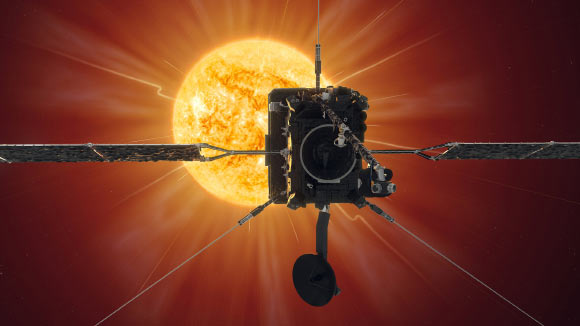ESA’s Solar Orbiter spacecraft, in collaboration with NASA, launched in February 2020 on its mission to study to Sun and it began collecting science data in June. Now, three of its ten instruments — the Energetic Particle Detector (EPD), the Radio and Plasma Waves (RPW) instrument, and the Magnetometer (MAG) — have released their first science data, revealing the state of our star in a ‘quiet’ phase.
Source: Sci News
The Sun is known to follow an 11-year cycle of sunspot activity and is currently almost completely free of sunspots.
This is expected to change over the coming years as sunspot activity ramps up, causing the Sun to become more active and raising the chances of adverse ‘space weather’ events, where the Sun releases huge amounts of material and energy in solar flares and coronal mass ejections.
Solar Orbiter has already flown inside the orbit of Venus, collecting some of the closest data to the Sun so far, and will get progressively closer in the coming years. It is currently orbiting close to the equator of the Sun, which in times of high activity would show a very warped magnetic field.
Currently, however, the Sun’s magnetic ‘equator’ is lying very flat to the true equator, allowing the spacecraft to observe fields from the northern magnetic hemisphere for weeks on end, when just a few degrees north of the equator.
Near times of high solar activity, when the Sun’s magnetic equator is more warped, it is not possible to see a single polarity of magnetic field for so long.
The data released today are part of Solar Orbiter’s commitment to releasing data within three months of it arriving on the ground — a tight schedule for any space mission.
“We want Solar Orbiter to be one of the most open space missions. This means open to the whole world, not only to the teams who have built the instruments,” said Solar Orbiter deputy project scientist Dr. Yannis Zouganelis, a researcher at ESA.
The work begins long before launch, with the various instrument teams getting ready to receive and process their data.
Once the instruments are taking data, the mission enters a calibration phase in which a lot of work is put in by each instrument team to understand how their instrument is working in space, whether the data coming back is as expected, and which instrumental and spacecraft effects need to be corrected for.
For example, instrument readouts depend on the temperature of the detector, but often the thermometers are by necessity located at a certain distance away. Thus, the data must be calibrated with the actual ‘in-orbit’ thermal behavior of the spacecraft.
Once the working instrument is understood, the teams process the data and send them to ESA’s European Space Astronomy Centre (ESAC), near Madrid. There, the data is archived at the ESAC Science Data Centre and made accessible to the public.
“It’s a coordinated effort involving dozens of people from many different teams, many different countries, and all parties have to work together, like an orchestra, to make sure that everything is ready at the right time,” Dr. Zouganelis said.
“When the data is received on the ground it is raw data, just ones and zeros. This is sent to us and we transform it into physical units that can be used for scientific purposes,” said EPD principal investigator Dr. Javier Rodríguez-Pacheco, a researcher at the University of Alcalá.
“Now any scientist from any country can get the data and do science with it. In fact, there are already hundreds of scientists working together to make sense out of this unique data,” Dr. Zouganelis said.
In tandem with the data release, a special issue of the journal Astronomy & Astrophysics is being published that contains mission and instrument descriptions.
Source: Sci News

































Leave a Comment
You must be logged in to post a comment.